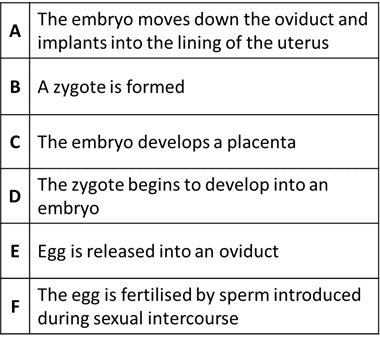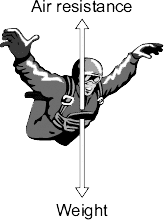A Star GCSE Biology Equivalency Revision
Question 1:
Yeast is a single celled fungus.
The diagram below shows a yeast cell containing features labelled A to F.
1a)
Fill in the gaps below to name each feature of a yeast cell, corresponding to the labels above.
[3 marks]
SOLUTION:
A: Cell wall
B: Cell membrane
C: Vacuole
D: Cytoplasm
E: Nucleus
1b)
Put a tick (✓ ) in the box next to each statement that applies to the yeast cell.
[2 marks]
SOLUTION:
Its DNA is located inside the nucleus
Question 2:
The heart is part of the circulatory system.
The diagram below shows a section through the human heart.
2a)
Which arrow, A, B, C or D, shows blood leaving the heart in the pulmonary artery to go
to the lungs?
[1 mark]
SOLUTION:
B
2b)
Which arrow, A, B, C or D, shows blood from the lungs entering the heart in the pulmonary vein?
[1 mark]
SOLUTION:
D
2c)
Valves in the circulatory system make sure blood only travels in one direction.
Name the type of blood vessel that has valves.
[1 mark]
SOLUTION:
Vein
Question 3:
3a)
The table below shows some events that occur during human reproduction.
Put these stages in order. The first stage corresponds to letter E.
[3 marks]
SOLUTION:
E F B D A C
3b)
During puberty, changes take place in the bodies of boys and girls called secondary sexual characteristics.
3b)i)
Which hormone controls the secondary sexual characteristics in boys?
[1 mark]
SOLUTION:
Testosterone
3b)ii)
Which hormone controls the secondary sexual characteristics in girls?
[1 mark]
SOLUTION:
oestrogen
Question 4:
The image below shows a tropical rainforest.
Population sizes are affected by both biotic and abiotic factors.
4a)
State two biotic factors in a tropical rainforest.
[2 marks]
SOLUTION:
Any 2 from:
- Food availability / competition
- Predators
- Disease
- Parasitism
- Presence of pollinating insects
- Availability of nesting locations
4b)
State two abiotic factors in a tropical rainforest.
[2 marks]
SOLUTION:
Any 2 from:
- Climate
- Light intensity
- Temperature
- Humidity
- Amount of rainfall / water availability
- Amount of sunlight / hours of daylight
- Soil conditions (any relevant points)
Question 5:
You may find it helpful to use the information on the Data Sheet when answering this question.
In the nucleus of an aluminium atom are:
13 protons
and 14 neutrons.
5a)
Complete these sentences.
5a)i)
The mass number of the aluminium atom is ………………………………..
[1 mark]
SOLUTION:
27
5a)ii)
In an atom of aluminium there are ………………………………… electrons.
[1 mark]
SOLUTION:
13
5b)
Why is an aluminium atom electrically neutral?
[2 marks]
SOLUTION:
Each proton has a positive charge and each electron has a negative charge.
There are equal numbers of protons and electrons in the atom / so charges cancel or balance (each other)
5c)
Complete the table for the element fluorine.
[3 marks]
SOLUTION:
Question 6:
In the carbon cycle the amounts of carbon dioxide and oxygen in the air are changed by several processes.
6a)
The names of some processes are given in the box below.
Choose the correct process for each box in the diagram.
The first one has been done for you.
[2 marks]
SOLUTION:
Respiration in the left box
Combustion in the right box
6b)
Fossil fuels, such as natural gas, react with oxygen.
Complete the word equation for this reaction.
\text{CH}_4 + 2\text{O}_2 \rightarrow \text{CO}_2 + \text{H}_2 \text{O}
…………..………… + oxygen \rightarrow carbon dioxide + ………..…………….
[2 marks]
SOLUTION:
methane
water
6c)
What problem is caused by the formation of large amounts of carbon dioxide?
[1 mark]
SOLUTION:
greenhouse effect (increased), or global warming, melting of polar ice caps, rising sea levels, climate change etc.
Question 7:
A molecule of ethene ( \text{C}_2 \text{H}_4 ) is represented as:
7a)
A sample of ethene is shaken with bromine water.
Complete the sentence.
The bromine water turns from orange to …………………………………………….. .
[1 mark]
SOLUTION:
Colourless
7b)i)
Many molecules of ethene join together to produce poly(ethene).
Complete the structure of the polymer in the equation.
[2 marks]
SOLUTION:
7b)ii)
Some carrier bags are made from poly(ethene).
Some carrier bags are made from cornstarch.
Suggest two benefits of using cornstarch instead of poly(ethene) to make carrier bags.
[2 marks]
SOLUTION:
Any 2 from:
- (polymers made from) cornstarch are biodegradable
- less space needed in landfill sites
- polymers from cornstarch come from a renewable source.
Question 8:
The diagram shows the forces acting on a parachutist in free fall.
The parachutist has a mass of 75 \text{ kg}.
Calculate the weight of the parachutist.
Show clearly how you work out your answer and give the unit.
[3 marks]
SOLUTION:
Weight =75 \times 10 = 750 \text{ N}
Question 9:
A student set up the electrical circuit shown in the figure below.
9a)
The ammeter displays a reading of 0.10 \text{ A}.
Calculate the potential difference across the 45 \, \Omega resistor.
[2 marks]
SOLUTION:
V= 0.10 \times 45 = 4.5 \text{ V}
9b)
Calculate the resistance of the resistor labelled R.
[3 marks]
SOLUTION:
Total resistance = \dfrac{12}{0.10} = 120 \, \Omega
R = 120 - (45 + 60) = 15 \, \Omega
9c)
State what happens to the total resistance of the circuit and the current through the circuit when switch S is closed.
[2 marks]
SOLUTION:
(total) resistance decreases, (so) current increases
Question 10:
The data given in the table below was obtained from an investigation into the refraction of light at an air to glass boundary.
10a)
Describe an investigation a student could complete in order to obtain similar data to that given in the table above.
Your answer should consider any cause of inaccuracy in the data.
[6 marks]
SOLUTION:
Indicative content:
- place a glass block on a piece of paper
- draw around the glass block and then remove from the paper
- draw a line at 90 \degree to one side of the block (the normal)
- use a protractor to measure and then draw a line at an angle of 20 \degree to the normal
- replace the glass block
- using a ray box and slit point the ray of light down the drawn line
- mark the ray of light emerging from the block
- remove the block and draw in the refracted ray
- measure the angle of refraction with a protractor
- repeat the procedure for a range of values of the angle of incidence
Possible source of inaccuracy:
- the width of the light ray
- which makes it difficult to judge where the centre of the ray is
(5 – 6 marks):
A detailed and coherent plan covering all the major steps is provided. The steps in the method are logically ordered. The method would lead to the production of valid results.
A source of inaccuracy is provided.
(3 – 4 marks):
The bulk of a method is described with mostly relevant detail. The method may not be in a completely logical sequence and may be missing some detail.
(1 – 2 marks):
Simple statements are made. The response may lack a logical structure and would not lead to the production of valid results.
0 marks:
No relevant content.
10b)
State the reason why light is refracted as it crosses from air into glass.
[1 mark]
SOLUTION:
velocity / speed of the light decreases / changes














